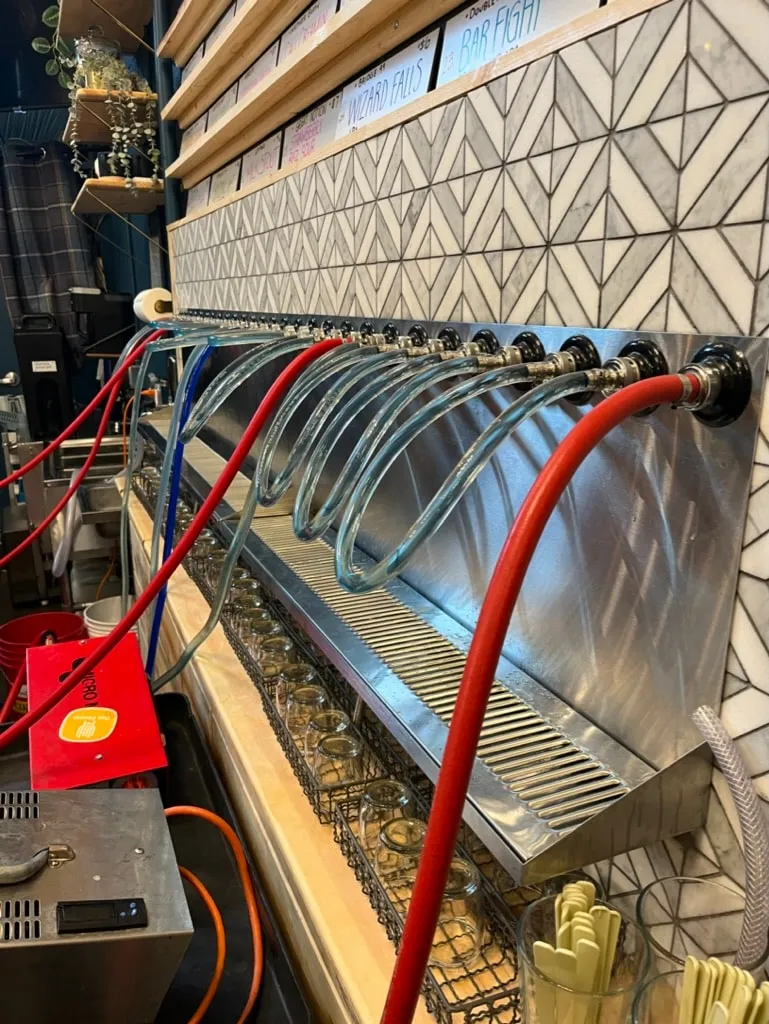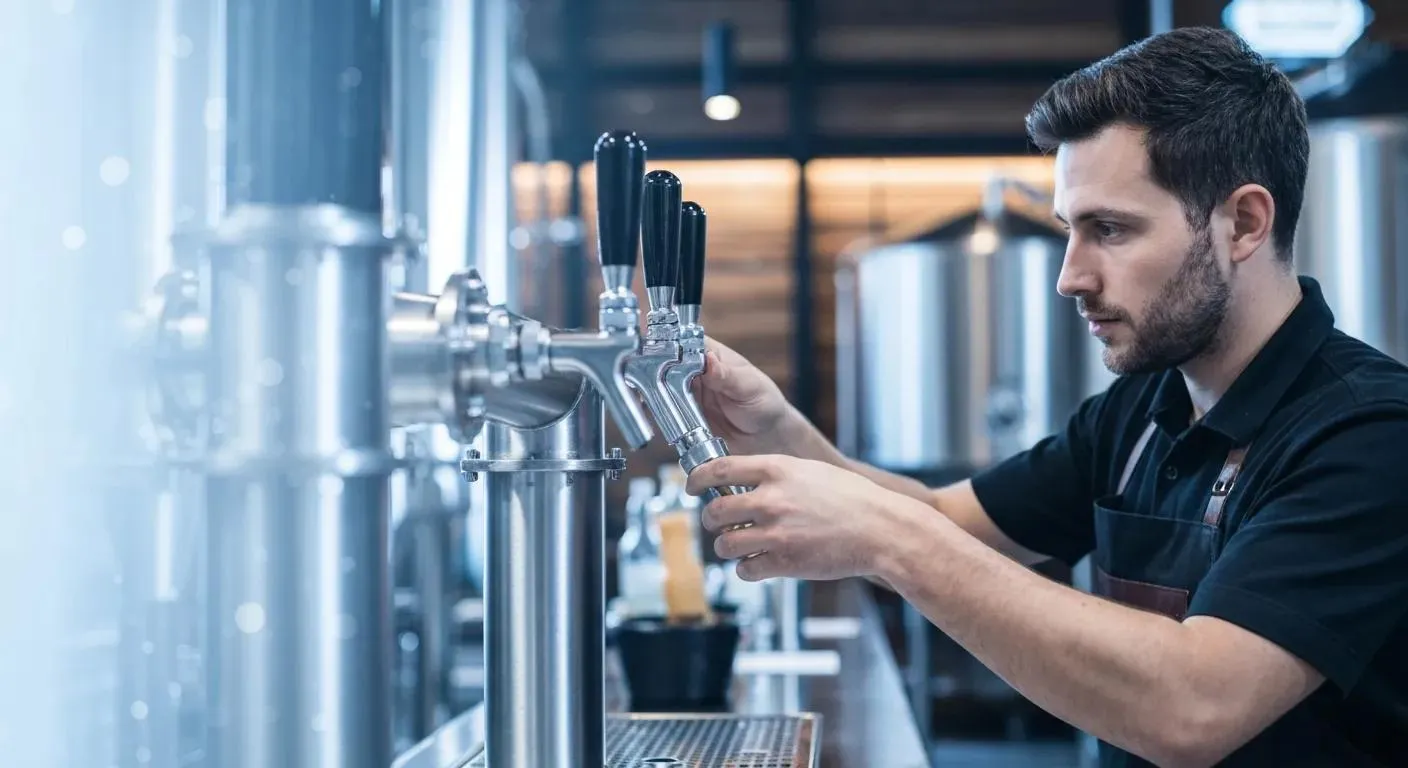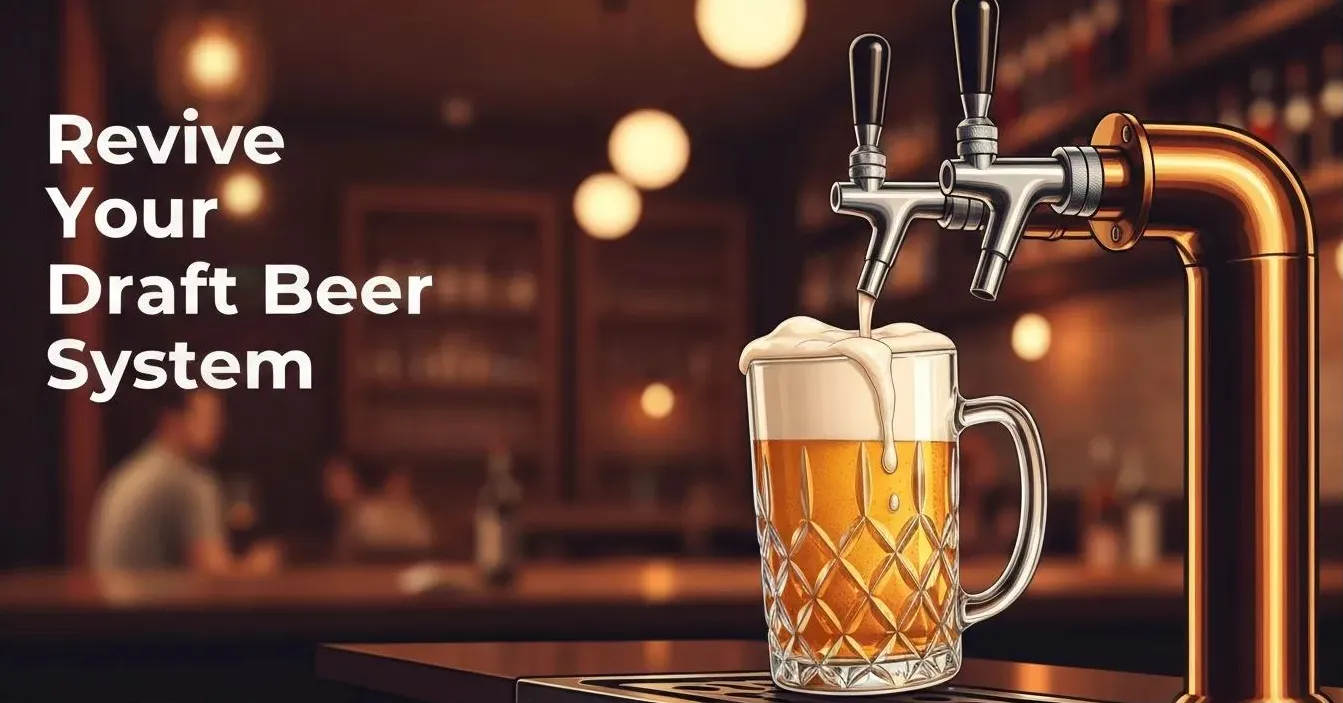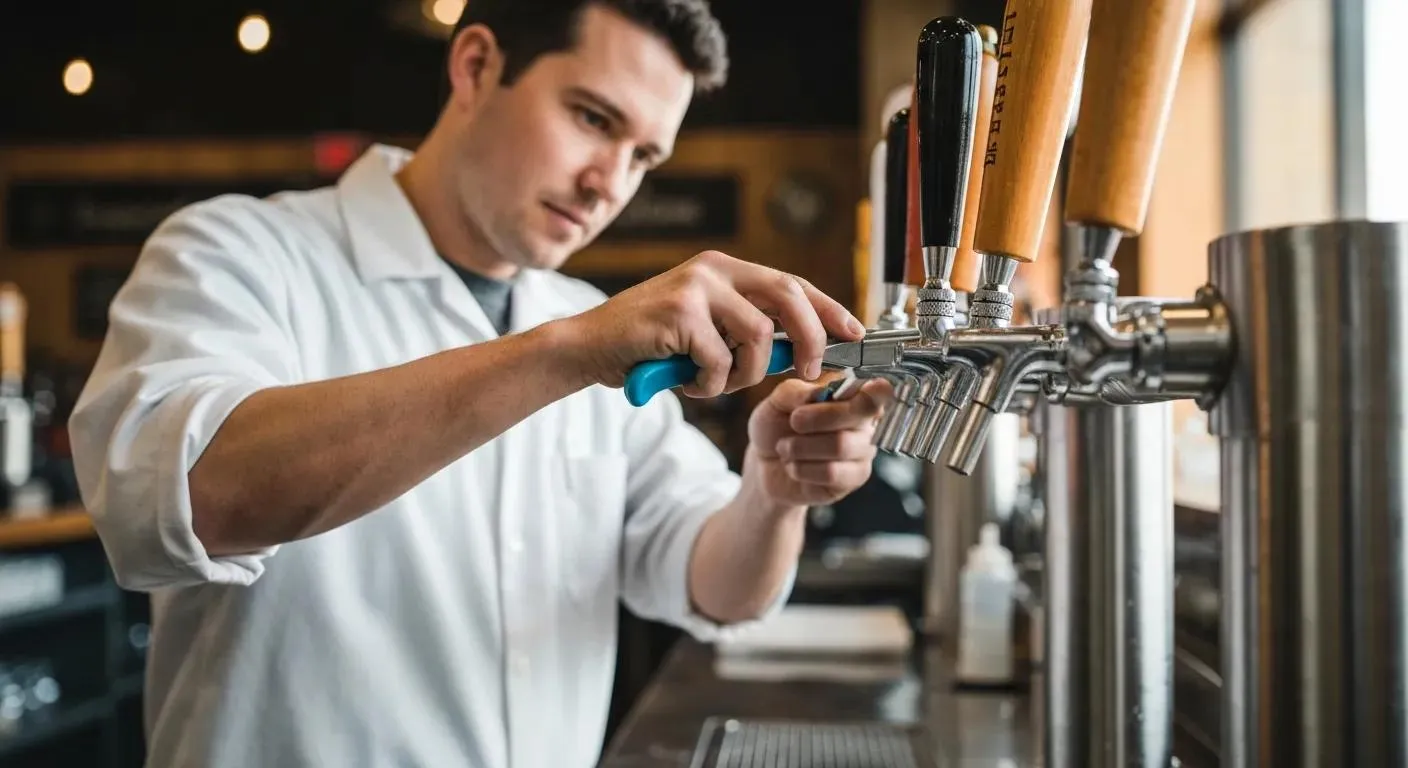Beer Line Cleaning Laws: How Often Should They Be Cleaned?

Maintaining clean beer lines is crucial for any establishment serving draft beer. Proper beer line cleaning not only ensures the beer retains its intended flavor profile but also protects customers from potential contamination. The frequency of cleaning draft beer lines can vary, largely depending on the volume of beer served and the types of beer that are dispensed. Industry experts suggest a minimum standard for cleaning frequency, citing that regular maintenance is key to optimal draft system performance.
If the lines are left uncleaned, there can be a significant impact on the quality of the beer, such as off-flavors and poor foam retention. Implementing a consistent cleaning routine is therefore essential, using the correct agents and equipment. Likewise, understanding and being able to troubleshoot common issues can save time and resources, ensuring that the draft system operates efficiently without serving subpar beer to customers.
Key Takeaways
- Regular cleaning is essential for maintaining beer quality and safety.
- Cleaning frequency should adhere to industry standards.
- Using appropriate cleaning agents and equipment prevents common issues.
Importance of Regular Cleaning
Regularly cleaning beer lines is crucial for preventing the buildup of bacteria, yeast, and mold which can lead to contaminated drinks, and off-flavors, and can even pose health risks. It is also essential for maintaining the overall quality and flavor of the beer that customers expect from a draft system, ensuring the delivery of quality draught beer.

Preventing Contaminants
Bacteria, yeast, and mold thrive in moist environments, making beer lines an ideal breeding ground for these unwanted contaminants. If the lines are not cleaned consistently, bacterial growth can occur, leading to the possibility of foamy beer or even health risks for consumers. To ensure the safety and cleanliness of beer lines, they should undergo a thorough cleaning process that eradicates these microorganisms effectively.
Maintaining Beer Quality and Flavor
To guarantee that each pint poured from a draft system retains its intended beer quality and flavor, clean beer lines are imperative. Dirty or contaminated lines can impart off-flavors to the beer, deviating from the brewer's intended taste profile. Furthermore, residues and buildup in unclean lines can cause the beer to become excessively foamy, detracting from the desired drinking experience. Regular line cleaning ensures that each glass of beer is served as the brewer intended, filling it with optimal taste and carbonation.

Cleaning Frequency and Industry Standards
Maintaining the cleanliness of beer lines is non-negotiable for ensuring the quality and taste of draught beer. The industry standards provide clear guidelines for regular cleaning schedules, emphasizing both the frequency and best practices essential for the optimal upkeep clean my beer lines. In some regions, local health departments inspect establishments serving food for compliance with sanitation standards, although there are no specific regulations governing the cleaning of beer lines.
Determining Appropriate Cleaning Intervals
To establish a regular cleaning schedule for bars and restaurants, it is necessary to assess certain variables such as the volume of beer served, the types of beer, and the quality of the water supply. These factors can significantly influence the buildup of proteins and biofilms within the beer lines. It is generally recommended that beer lines be cleaned at a minimum every two weeks. However, in some instances, especially with high-volume establishments, a weekly cleaning might be best to guarantee freshness and hygiene.

Adhering to Brewers Association Guidelines
The Brewers Association stipulates specific protocols for beer line cleaning chemical maintenance. They advise using an alkaline detergent cleaner and recirculating it through the beer lines for at least 15 minutes at velocities up to two gallons per minute. This practice forms part of the best practices for line cleaning and is considered an industry standard to prevent contamination and maintain beer quality.
Following these guidelines ensures that establishments are consistent with industry standards, fostering trust and confidence in their draught beer offerings. Beer distributors also play a critical role in maintaining clean beer lines to ensure quality service and flavor for consumers.
Cleaning Process Step-by-Step With Recirculating Pumps
Maintaining a draft beer system requires regular and thorough cleaning to ensure the quality of the beer served. Neglecting this maintenance can lead to flavor contamination and equipment damage. The cleaning process typically involves several steps, including an initial rinse, the application of cleaning solutions, and the reassembling of the system components.

The Draught Beer Quality Manual provides a detailed step-by-step procedure for cleaning beer lines with an electric recirculating pump. Here's a summary of the steps outlined in the manual:
- Prepare the Cleaning Solution: Mix the cleaning solution according to the manufacturer's instructions. Ensure the solution is at the correct concentration and temperature.
- Disconnect Kegs: Remove kegs from the system to prevent the cleaning solution from entering them.
- Connect the Pump Setup: Attach the recirculating pump setup to the system. Ensure that the setup is correctly connected to both the beer lines and the faucet.
- Circulate Cleaning Solution: Turn on the pump to circulate the cleaning solution through the beer lines. Follow the recommended circulation time to ensure thorough cleaning. Usually 15 minutes from the time the entire draft system is full of cleaning chemicals.
- Rinse with Water: After circulating the cleaning solution, rinse the system with clean water to remove any residual cleaner. It's crucial to rinse thoroughly to ensure no cleaning solution remains in the lines. Use PH paper to verify the chemical is out of the draft system.
- Reconnect Kegs: Once the lines are rinsed and clear of any cleaning solution, reconnect the kegs to the system.
- Check System: Before serving beer again, check the system for any leaks or issues that may have arisen during the cleaning process.
For detailed instructions, including the specific concentration of cleaning solutions, temperatures, and circulation times, refer to the Draught Beer Quality Manual. This manual is a comprehensive resource for maintaining draught beer quality through proper system maintenance and cleaning.
Selecting the Right Cleaning Agents and Equipment
Selecting the appropriate, cleaning chemicals, agents, and equipment is paramount for the maintenance of beer lines. Using the right materials and tools ensures that beer lines remain clean, which in turn maintains the quality of the beer served.
Understanding Different Types of Cleaners
The Draught Beer Quality Manual recommends specific cleaning chemicals for draft beer line cleaning, emphasizing the importance of using the right chemicals to ensure the lines are cleaned effectively without damaging the system or affecting the beer's quality. Here's a summary of the best cleaning chemicals for draft beer line cleaning as outlined in the manual:
Caustic-Based Cleaners
- Primary Choice: Caustic cleaners are the primary chemicals recommended for draught line cleaning. These cleaners are effective in removing organic material buildup, which prevents the growth of beer-spoiling bacteria.
- Ingredients: The caustic cleaners should specifically be designed for draught line cleaning and may use either sodium hydroxide, potassium hydroxide, or a combination of both.
- Concentration: For routine cleaning, a working strength of at least 2% caustic (as sodium hydroxide) is recommended. A 3% caustic solution is advised for problem systems, heavily soiled systems, or older lines.
- Temperature: Mix the caustic solution with water warmed to a temperature between 80°F and 110°F.
- Contact Time: The caustic cleaner must remain in contact with the draught line for at least 15 minutes during recirculation cleaning or 20 minutes for static or pressure canister cleaning.
Acid-Based Cleaners
- Use: Acid-based cleaners are used in addition to caustic cleaners, not as a replacement. They are effective in removing inorganic materials like beer stone (calcium oxalate) and water stone (calcium carbonate).
- Ingredients: Suitable acid-based line cleaners for draught line cleaning contain solutions of phosphoric acid. Hydrochloric acid, which corrodes stainless steel, and nitric acid, not compatible with nylon products, should not be used.
- Concentration and Temperature: Mix the acid-based line cleaner to the manufacturer's recommended solution strength, using water warmed to between 80°F and 110°F.
- Contact Time: Acid solution must also remain in contact with the draught line for at least 15 minutes during recirculation cleaning or 20 minutes for static or pressure canister cleaning.
Additional Recommendations
- Routine Use: Routine use of caustic cleaning solutions with EDTA or other chelating agent additives can help reduce calcium oxalate buildup, potentially decreasing the need for regular acid-based cleaning.
- Safety: Never use solutions that contain any amount of chlorine for regular system maintenance, as chlorine is not compatible with some beer line materials and can cause flavor changes in draught beer.
These guidelines ensure that the cleaning process effectively maintains the quality and safety of the draught beer system. It's crucial to follow the manufacturer's instructions for mixing and using these chemicals to avoid damaging the system or compromising beer quality.
Choosing Proper Cleaning Tools and Accessories
The right tools are required to apply these cleaners properly. A cleaning kit typically comprises a hand pump or bucket and a cleaning keg, which helps circulate the cleaning solution through the beer lines. For instance, a spanner wrench is crucial when attaching and removing faucets. It's important to consider the material of the beer lines to choose compatible tools that won't cause damage.
Safety glasses should be worn to protect the eyes from any potential splashes of cleaning agents. Lastly, a sanitizer must be used after cleaning to ensure that all microbial life is eradicated from the bar and beer lines. It's advised that establishments invest in comprehensive cleaning kits, which contain most of the necessary tools for a thorough cleanup.
Troubleshooting Common Issues
In addressing issues related to draft beer systems, it's crucial to identify and correct problems rooted in improper maintenance practices that can lead to off-tastes, suboptimal aromas, and poor carbonation control. Effective troubleshooting is integral to ensuring a better drinking experience and beer line cleanliness.
Addressing Persistent Off-Tastes and Aromas
Persistent off-tastes and aromas in draft beer are often indicative of bacterial, yeast, or mold contaminations within the beer lines. To eliminate these issues:
- Conduct a thorough cleaning using recommended cleaning agents, ensuring that the entire system, including taps, lines, and faucets, is sanitized.
- Implement a regular cleaning schedule, ideally every two weeks, to prevent microbial growth.
Preventing Foam and Over-Carbonation Problems
Foam issues in draft beer can stem from over-carbonation, temperature inconsistencies, or cleanliness problems. Optimal carbonation levels are key to the perfect pour. To prevent these problems:
- Verify that the beer is stored at the correct temperature and that the carbonation pressure settings align with the manufacturer's recommendation.
- Regular line cleaning will safeguard against foaming issues caused by buildups, ensuring consistent beer quality.
Regular maintenance and prompt troubleshooting contribute significantly to the quality of draft beer service.

Frequently Asked Questions
Maintaining the quality of served beer requires regular cleaning of the beer lines. This section answers common questions regarding the cleaning frequency and recommends cleaning practices for beer draft systems.
What is The Recommended Frequency For Cleaning Beer Lines to Ensure Quality?
The best practice to ensure quality beer is to clean the beer lines every two weeks in commercial settings. In-home environments, cleaning every time a keg is changed or every five weeks is advised, as mentioned by the Brewers Association.
Can Neglected Beer Line Cleaning Impact The Taste and Safety of The Beer Served?
Yes, neglected beer line cleaning can lead to the buildup of microorganisms, impacting the taste and safety. The beer may develop off-flavors and become cloudy, affecting its quality, as explained by the Homebrew Academy.
What Are The Signs That Indicate a Beer Line Requires Cleaning?
Signs that a beer line needs cleaning include a noticeable change in the taste or smell of the beer, cloudiness, or excessive foam, indicating the presence of yeast, bacteria, or beer stone buildup.
Is it Necessary to Rinse Beer Lines With Water After Using Detergent, and If So, For How Long?
It is essential to rinse beer tap lines with clean water after using detergent to ensure no chemical residue is left. This should be done for a duration of at least 15 minutes, ensuring the return of a neutral pH, as indicated by The Ultimate Guide to Beer Line Cleaning.
What Are The Potential Health Effects Associated With Consuming Beer From Dirty Lines?
Consumption of beer from dirty lines can lead to exposure to harmful bacteria, which may cause illness. It's crucial to maintain cleanliness to protect patrons' health.
Are There Specific Legal Requirements For Beer Line Maintenance That Vary by State?
Legal requirements for beer line maintenance can vary by state, with some requiring regular cleaning at intervals mandated by law. Establishments must comply with their local health codes and regulations.
Summary
Maintaining clean beer lines is crucial for ensuring the quality and taste of draught beer. Beer lines should be cleaned at least once every two weeks using an alkaline detergent cleaner to effectively remove proteins and build-ups. The cleaning solution should be recirculated for a minimum of 15 minutes, ideally at a flow rate of two gallons per minute.
Some industry standards advocate for a more frequent cleaning schedule, such as every seven days, to preserve optimal beer quality. Consistency in cleaning not only provides the best-tasting beer but also reduces the risk of bacterial contamination.
Maintaining a regular beer line cleaning regimen benefits in several ways:
- Improves Taste: Regular cleaning prevents off-flavors caused by bacteria and yeast build-up.
- Better Foam Retention: Cleaner beer lines result in a proper foam head on the beer.
- Cost Efficiency: Prevents costly waste from spoiled beer.
- Customer Satisfaction: Ensures customers receive the best possible beer experience.
- Higher Pint Keg Yield: Minimizing Pour Costs and Higher Return on Investment
Depending on usage and the type of beer being dispensed, these frequencies may need to be adjusted, as recognized by Coalition Brewing, highlighting that the volume and type of beer can influence the necessary cleaning schedule. Beer line cleaning is vital for any establishment serving draught beer to maintain high standards.
If you are located in Central Oregon and need your beer lines cleaned. We would like to help you with that. Please reach out to us.



